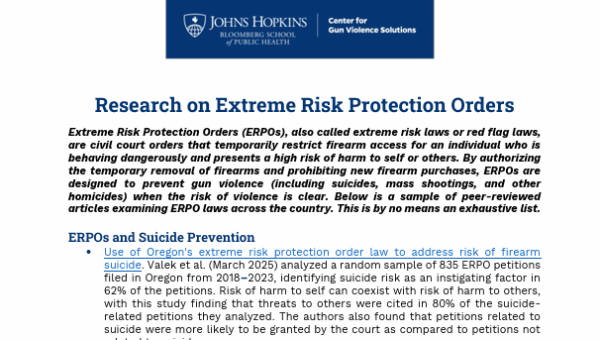 Johns Hopkins Center for Gun Violence Solutions Sep. 2025 Research on Extreme Risk Protection Orders, An Evidence-Based Policy That Saves Lives
Johns Hopkins Center for Gun Violence Solutions Sep. 2025 Research on Extreme Risk Protection Orders, An Evidence-Based Policy That Saves Lives ERPOs empower law enforcement, family members, and others to work with courts to temporarily remove firearms from those who pose a danger to themselves or others. Research suggests that ERPOs are a valuable gun violence prevention tool that can save lives.
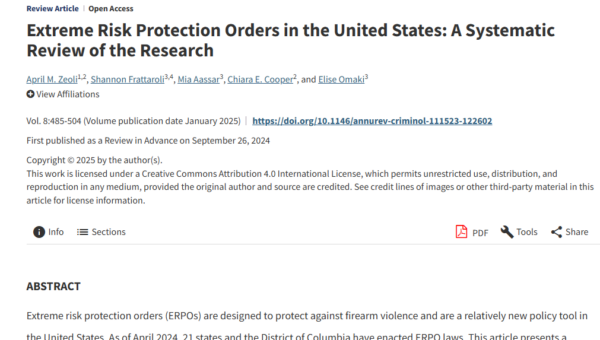 ANNUAL REVIEW OF CRIMINOLOGY (JOURNAL) Jan. 2025 Extreme Risk Protection Orders in the United States: A Systematic Review of the Research
ANNUAL REVIEW OF CRIMINOLOGY (JOURNAL) Jan. 2025 Extreme Risk Protection Orders in the United States: A Systematic Review of the Research This article presents a systematic review of the literature concerning ERPO laws, their use, and their effectiveness. It also provides existing evidence regarding ERPO implementation and effectiveness and carves a pathway forward for future research, policy, & practice.
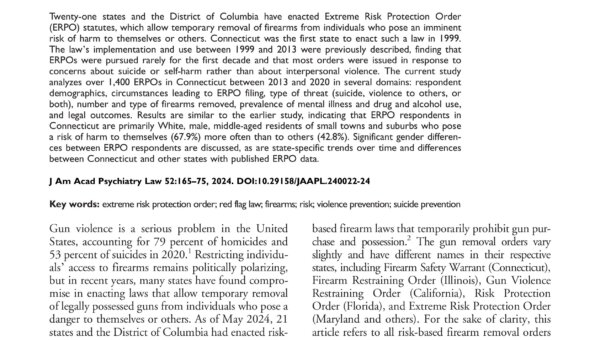 THE JOURNAL OF THE AMERICAN ACADEMY OF PSYCHIATRY AND THE LAW Jun. 2024 Extreme Risk Protection Orders in Connecticut, 2013-2020
THE JOURNAL OF THE AMERICAN ACADEMY OF PSYCHIATRY AND THE LAW Jun. 2024 Extreme Risk Protection Orders in Connecticut, 2013-2020 This study analyzes over 1,400 ERPOs in Connecticut between 2013 and 2020 in several domains: respondent demographics, circumstances leading to ERPO filing, type of threat, number and type of firearms removed, prevalence of mental illness and drug and alcohol use, and legal outcomes.
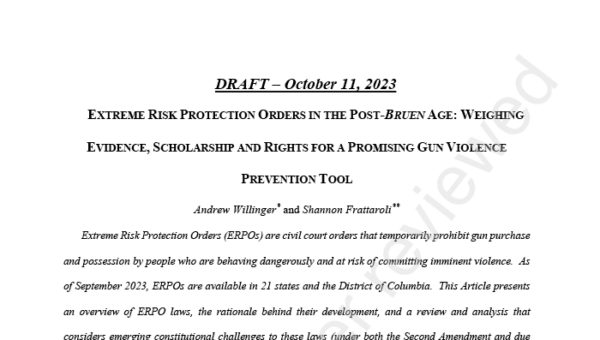 FORDHAM URBAN LAW JOURNAL Oct. 2023 Extreme Risk Protection Orders in the Post-Bruen Age: Weighing Evidence, Scholarship, and Rights for a Promising Gun Violence Prevention Tool
FORDHAM URBAN LAW JOURNAL Oct. 2023 Extreme Risk Protection Orders in the Post-Bruen Age: Weighing Evidence, Scholarship, and Rights for a Promising Gun Violence Prevention Tool This Article presents an overview of ERPO laws, the rationale behind their development, and a review and analysis that considers emerging constitutional challenges to these laws (under both the Second Amendment and due process protections) in the post-Bruen era.
 PREVENTIVE MEDICINE (JOURNAL) Dec. 2022 Extreme risk protection orders in response to threats of multiple victim/mass shooting in six U.S. states: A descriptive study
PREVENTIVE MEDICINE (JOURNAL) Dec. 2022 Extreme risk protection orders in response to threats of multiple victim/mass shooting in six U.S. states: A descriptive study Researchers collected and abstracted information from ERPO cases from six states (California, Colorado, Connecticut, Florida, Maryland, and Washington).
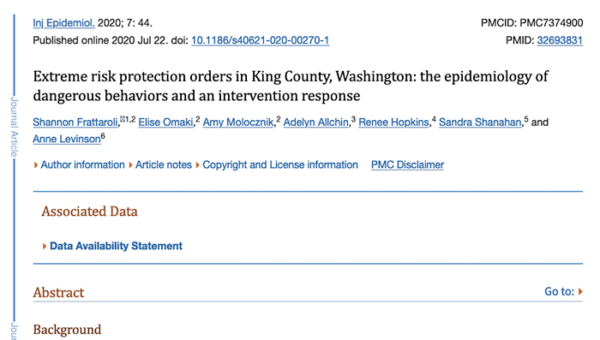 INJURY EPIDEMIOLOGY (JOURNAL) Jul. 2020 Extreme risk protection orders in King County, Washington: The epidemiology of dangerous behaviors and an intervention response
INJURY EPIDEMIOLOGY (JOURNAL) Jul. 2020 Extreme risk protection orders in King County, Washington: The epidemiology of dangerous behaviors and an intervention response The early experience of King County offers important insight into how early adopters of these laws are incorporating EPROs into their approach to gun violence prevention.
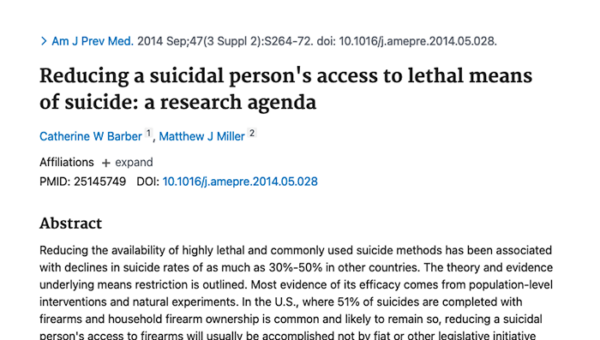 AMERICAN JOURNAL OF PREVENTIVE MEDICINE Sep. 2014 Reducing a suicidal person’s access to lethal means of suicide: a research agenda
AMERICAN JOURNAL OF PREVENTIVE MEDICINE Sep. 2014 Reducing a suicidal person’s access to lethal means of suicide: a research agenda Reducing the availability of highly lethal and commonly used suicide methods has been associated with declines in suicide rates of as much as 30%-50% in other countries. The theory and evidence underlying means restriction is outlined.




